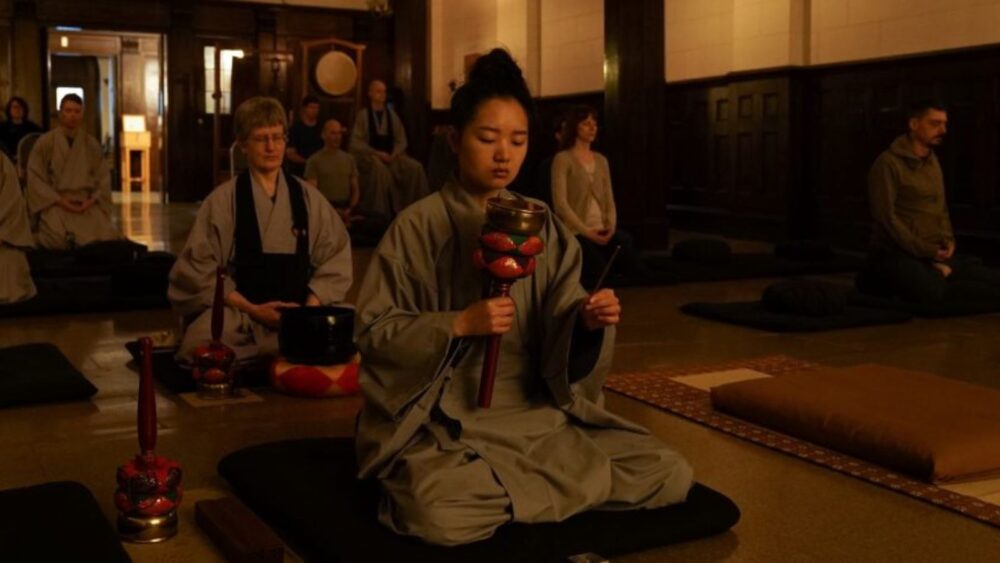
NEW YORK — On a recent Sunday morning, amid intermittent rain, worshippers leapt around growing puddles on the sidewalk outside Fire Lotus Temple in Brooklyn before entering through the large wooden doors. Located on the corner of Third Avenue and State Street in Park Slope, the temple’s aged brick facade and wooden placards stood out among the surrounding residential buildings. Upon entering the temple, the smell of incense greeted each visitor, inviting them into the sanctuary. One by one, people lined up in the vestibule, waiting to bow at the altar inside the temple to clear and purify their minds before crossing the threshold and entering the sacred space.
The sanctuary was a large room with low ceilings. There were 40 meditation mats, spaced out in even rows on the floor in front of the temple’s altar. Mara Leighton, a Brooklyn native dressed in navy sweats with her long brown hair thrown into a messy bun, entered the sanctuary minutes before the service began. She found a meditation cushion to her liking, and sat cross-legged, closing her eyes, taking a deep breath and settling into her mat.
After an opening procession and a series of bows, a Buddhist priest handed out liturgy books before taking a seat at the front of the room next to two large singing bowls. These bronze bowls—when gently struck or played with a mallet—produce rich, resonant tones that support the chanting by setting the rhythm and creating a meditative atmosphere. Everyone opened their books to page three, “The Heart Sutra.” The priest scanned the room, waiting for everyone to settle before picking up a wooden mallet and slowly tracing the rim on the bowl three times. As the third ring started to fade, another priest made his way to a large bronze gong, or kesu, sitting in the back corner of the room. There was a brief pause, and then the priest struck the gong.
BONG.
The sound echoed through the sanctuary, and the head priest stood and chanted, “Maha Prajna Paramita Heart Sutra.” Then a third priest picked up a mallet and started banging a wooden drum carved like a fish holding a pearl in its mouth.
BOOM. BOOM. BOOM.
There was a moment of silence, and then the congregation joined in with “Avalokiteshvara Bodhisattva, doing deep Prajna Paramita,” spoken in traditional Sanskrit. The loud, rhythmic beats reverberated through the room. Even standing on thick mats, you still could feel the vibrations in your feet. Leighton stood, with her sock feet balancing half on her mat, glancing around the room, doing her best to pronounce the foreign lyrics. The chants got a little louder during the English verses, “Form is exactly emptiness, emptiness exactly form. Sensation, conception, discrimination, awareness are likewise like this.”
The Heart Sutra is the most popular sutra, or sacred teaching, in Mahāyāna Buddhism. Every morning, Buddhists around the world chant this sutra together as a reminder that form is an illusion. The Sutra goes through five skandhas, or the mental factors responsible for the rise of craving and clinging: form, sensations, perception, formations, and consciousness. The lyrics encourage Buddhists to release association with form to connect with a higher realm. But the chanting is not about the lyrics; it’s an invitation to allow the practice to carry them beyond wisdom, towards “wisdom beyond wisdom,” to a far shore of awakening that exists beyond suffering.
The resonant sounds filled the air, pulsing vibrations swirled through the sanctuary. Everyone chanted in unison, “Far beyond deluded thoughts; this is Nirvana.” As they chanted the final words of the Heart Sutra, translated as “Gone, gone, everyone gone to the other shore, awakening, svaha, the perfection of wisdom,” all the voices funneled together in a deep monotoned decrescendo, ending in abrupt silence.
